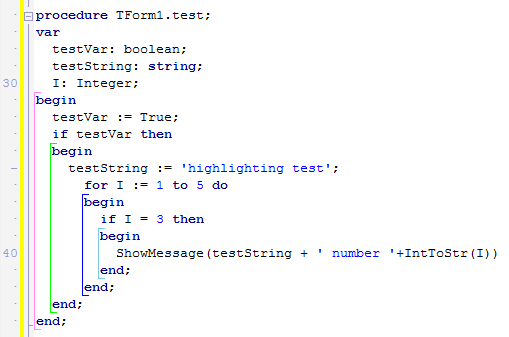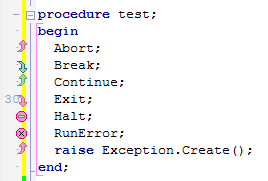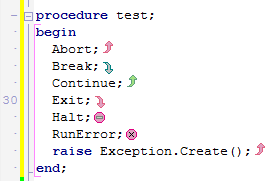Code Editor
Go Up to Getting Started with RAD Studio
The Code Editor and the Form Designer occupy the center pane of the IDE window. The Code Editor is a full-featured, customizable UTF8 editor that provides syntax highlighting, multiple undo capability and context-sensitive help for language elements.
As you design the user interface for your application, RAD Studio generates the underlying code. When you modify object properties, your changes are automatically reflected in the source files.
Because all of your programs share common characteristics, RAD Studio autogenerates code to get you started. You can think of the autogenerated code as an outline that you can examine to create your program.
Code Editor Context Menu describes the context menu commands for the Code Editor.
The video RAD Studio Code Editor, by Mike Rozlog provides good hints and tips.
To help you write code, the Code Editor provides the features described in this section.
Contents
- 1 Change Bars
- 2 Indenting Code
- 3 Formatting Code
- 4 Code Insight
- 5 Navigation Toolbar
- 6 Code Navigation
- 7 Live Templates
- 8 Code Folding
- 9 Refactoring
- 10 SyncEdit
- 11 To-Do Lists
- 12 Keystroke Macros
- 13 Bookmarks
- 14 Synchronizing Prototypes
- 15 Structural Highlighting
- 16 Smart Keys
- 17 Selection Expansion
- 18 Block Comments
- 19 Using F1 Help
- 20 Syntax Highlighter
- 21 Customize Editor's Font Size
- 22 File Encoding
- 23 See Also
Change Bars
The left margin of the Code Editor displays a green change bar to indicate lines that have not been changed in the current editing session. A yellow change bar indicates that changes have been made since the last File > Save operation.
You can, however, customize the change bars to display in colors other than the default green and yellow. Select Tools > Options > User Interface > Editor Options > Color. In the Element drop-down menu, select Modified Line then change the foreground and the background colors.
Indenting Code
You can use the Tab key to indent the current line of code or a block of code in the Code Editor. The number of spaces that the Tab key indents is determined by the Block indent option on the Tools > Options > User Interface > Editor Options > Language option.
- To indent a line of code, place the cursor at the beginning of the line and press
Tab. - To indent an entire block of code, highlight the code block and press
Tab. - To move text to the left ("outdent"), use
Shift + Tab.
Formatting Code
RAD Studio provides the customizable source code formatter. Editing Delphi or C++ code in the Code Editor, you can apply the Format Source context menu command (or the Edit > Format Source menu command) to format the source code. You can set the Indentation, Spaces, Line Breaks, Capitalization, and Align formatting options under the Formatter group in the Options dialog box (Tools > Options > Language >Formatter). Notice that the Format Source command implements automatic formatting of your code. It takes into account only formatting options specified in the Options dialog box and totally overwrites all your manual formatting implemented in the Code Editor. For example, it ignores your manual code indenting. You can select a block of code and call the Format Source command so that only this block will be formatted.
Code Insight
Code Insight refers to a subset of features embedded in the Code Editor (such as Code Completion, Parameter Completion, Code Hints, Tooltip Expression, Tooltip Insight, Go To Definition, Block Completion, Class Completion, and Error Insight) that aid in the code writing process. These features help identify common statements you want to insert into your code, and assist you in the selection of properties and methods. For more details about these features, go to Code Insight Reference.
To enable and configure Code Insight features, choose Tools > Options > User Interface > Editor Options > Language and click on Code Insight option.
Code Completion — Ctrl+Space
The Code Completion feature displays a drop-down list of all items (methods, variables, properties and so forth) that contain the typed string anywhere in their name.
To invoke Code Completion, press Ctrl+Space while using the Code Editor. Select the character and press Enter to insert the text in the code at the cursor location.
For example:
C++
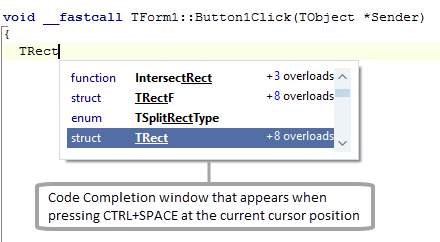
Delphi
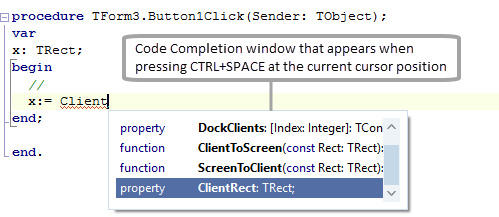
The Navigation Toolbar is displayed at the top of the Code Editor, and it helps you move through your code. Each dropdown shows their function when no text is typed in yet.
From left to right, the Navigation Toolbar contains the following controls:
- Used Units: The drop-down menu attached to this button
 displays the list of all the units that the current unit uses. Chose a unit from the list to open such a unit. The menu displays the units in declaration order. You can also open the drop-down menu pressing the shortcut
displays the list of all the units that the current unit uses. Chose a unit from the list to open such a unit. The menu displays the units in declaration order. You can also open the drop-down menu pressing the shortcut CTRL+ALT+N & CTRL+ALT+U. - File Sections: The drop-down menu attached to this button
 displays a list of the sections in the file. These sections can include Top of File, Interface Section, Interface Uses Clause, Implementation Section, Implementation Uses Clause, Initialization Section, and Bottom of File. Choose one of these sections to display it, and to place the cursor at the beginning of such section. You can also open the drop-down menu pressing the
displays a list of the sections in the file. These sections can include Top of File, Interface Section, Interface Uses Clause, Implementation Section, Implementation Uses Clause, Initialization Section, and Bottom of File. Choose one of these sections to display it, and to place the cursor at the beginning of such section. You can also open the drop-down menu pressing the CTRL+ALT+N & CTRL+ALT+Sshortcut. - Types: This combo box includes the names of all the types that the current unit declares. Choose one of these types to move the cursor to the declaration of that type. The
CTRL+ALT+N & CTRL+ALT+Tshortcut opens the types combo box. - Methods: This combo box includes the names of all procedures and functions of the current unit. Choose one of these items to move the cursor to the implementation of the procedure or function. The
CTRL+ALT+N & CTRL+ALT+Pshortcut opens the methods combo box. - Project Symbol Search: The
 button allows you to search for all symbols in the active selected project. The
button allows you to search for all symbols in the active selected project. The CTRL+ALT+N & CTRL+ALT+Fshortcut opens the project symbol search tool. The project symbol search dropdown window shows all the symbols in the project, and starts to filter them as you type. The search window displays any search that matches a substring of the symbol name; for example, about matches AboutBox, TAboutBox, and reabout.
When searching for a type or method on each dropdown, initially all results will be shown, and when you start to write the desired type or method you are looking for, the search match is syntax highlighted, making the search more intuitive and clear:

The navigation toolbar also follows the editor theme colors, not the IDE theme colors:

To hide the Navigation Toolbar, follow the steps defined in: How to Hide the Navigation Toolbar.
For further details, see How to Use the Navigation Toolbar.
The sections below describe features that you can use to navigate your code while you are using the Code Editor.
Method Hopping
You can navigate between methods using a series of editor hotkeys. You can also lock the hopping to occur only within the methods of the current class. For example, if class lock is enabled and you are in a method of TComponent, then hopping is only available within the methods of TComponent.
The keyboard shortcuts for Method Hopping are as follows:
Ctrl+Q^L-- toggles class lock.Ctrl+Alt+Up arrow-- moves to the top of the current method, or the previous method.Ctrl+Alt+Down arrow-- moves to the next method.Ctrl+Alt+Home-- first method in source.Ctrl+Alt+End-- last method in source.Ctrl+Alt+Mouse_Wheel-- scrolls through methods.
Finding Classes
Allows you to find classes. Use the Search > Find Class command to see a list of available classes that you can select. After you choose one, the IDE navigates to its declaration.
Finding Units
If you are programming in the Delphi language, you can use a refactoring feature to locate namespaces or units. Use the Find Unit command to locate and add units to your code file.
Finding the Next and Previous Changes
As you edit code, you can use keystrokes to quickly navigate to the Next and the Previous changes that you have made. The keyboard shortcuts are:
Ctrl+Shift+F7-- moves to the previous line modified since the file was opened (green marking in the gutter).Ctrl+Shift+F8-- moves to the next line modified since the file was opened (green marking in the gutter).Alt+Shift+F7-- moves to the previous line modified since the last save (yellow marking in the gutter).Alt+Shift+F8-- moves to the next line modified since the last save (yellow marking in the gutter).
If the next or previous line is in an elided (folded) block, the block is unfolded. Code folding is described later in this topic.
Keystrokes are the same for the following keyboard mappings: Default, IDE classic, Brief, and Epsilon. The Visual Studio and Visual Basic keyboard mappings do not have keystrokes for Next/Previous change.
Searching Source Code for Usages
If you are programming in the Delphi language, you can use the Search for Usages feature to find usages of classes, methods, variables, and overriding methods, derived classes, and implemented interfaces in your source code projects.
Live Templates
Live Templates allow you to have a dictionary of pre-written code that can be inserted into your programs while you're working with the Code Editor. This reduces the amount of typing that you must do.
Use the links at the end of this topic to learn more about creating and using Live Templates.
Code Folding
Code folding lets you collapse or expand regions or blocks of code. Collapsing your code creates a hierarchical view of the code and makes it easier to read and navigate. The collapsed code is not deleted but hidden from view until you expand it. Code folding is on by default.
To use code folding, click the plus (+) and minus (-) signs located on the left edge of the Code Editor:
- Click the plus (+) sign to expand the associated region of code.
- Click the minus (-) sign to collapse the associated region of code.
To enable/disable code folding:
- Use the Code Folding check box on the Tools > Options > User Interface > Editor options.
- Use the keyboard shortcut
Ctrl+Shift+K+O.
You can also use the context menu Fold command to fold specific types of regions, such as Types, Methods, XML Doc comments (for Delphi), and the 'Nearest' region. The Fold and Unfold commands are described in Code Editor Context Menu. For more information about code folding, including how to create code folding regions, see Using Code Folding.
Refactoring
Refactoring is the process of improving your code without changing its external functionality. For example, you can turn a selected code fragment into a method by using the extract method refactoring. The IDE moves the extracted code outside of the current method, determines the needed parameters, generates local variables if necessary, determines the return type, and replaces the code fragment with a call to the new method. Several other refactoring methods, such as renaming a symbol and declaring a variable, are also available.
SyncEdit
Video! Video: Sync Editing in RAD Studio, by Mike Rozlog
The Sync Edit feature lets you simultaneously edit identical identifiers in code. As you change the first identifier, the same change is performed automatically on the other identifiers. You can also set jump points to navigate to specific sections of your code.
To-Do Lists
A To-Do List records tasks that need to be completed for a project. After you add a task to the To-Do List, you can edit the task, add it to your code as a comment, indicate that it has been completed, and then remove it from the list. You can filter the list to display only those tasks that interest you.
Keystroke Macros
You can record a series of keystrokes as a macro while editing code. After you record a macro, you can play it back to repeat the keystrokes during the current IDE session. Recording a macro replaces the previously recorded macro.
Bookmarks
Bookmarks provide a convenient way to navigate long files. You can use two different types bookmarks in the Code Editor: Toggle Bookmarks and Stack Bookmarks.
Toggle Bookmarks
You can mark a location in your code with a toggle bookmark and jump to that location from anywhere in the file.
When you set a bookmark, a book icon ![]() is displayed in the left gutter of the Code Editor. You can use up to ten bookmarks, numbered 0
is displayed in the left gutter of the Code Editor. You can use up to ten bookmarks, numbered 0 ![]() through 9
through 9 ![]() , within a file.
, within a file.
You can drag-and-drop bookmark icons in the gutter of the Code Editor, and a moved bookmark has the number of the original bookmark.
For further details, see Using Bookmarks.
Stack Bookmarks
You can use stack bookmarks to navigate through your code. You can drop stack bookmarks in different places of your code adding them in a pile order; you can then navigate back through the pile.
When you place a stack bookmark, this icon ![]() is displayed in your code indicating the position of the stack bookmark.
is displayed in your code indicating the position of the stack bookmark.
For further details, see Using the Bookmark Stack.
Synchronizing Prototypes
RAD Studio provides the Sync Prototypes feature to synchronize the interface and implementation copies of your Delphi method prototypes.
The Sync Prototypes feature is only for Delphi; and allows you to sync the type of method (function, procedure, constructor, or destructor), its parameters, parameter types, parameter modifiers, and the function return type. You cannot sync the function name or the function modifiers.
If you want to sync a method prototype:
- Make any modification in the interface or implementation of your method prototype.
- Press the Sync Prototypes shortcut
CTRL+SHIFT+ALT+P, or Sync Prototypes in the context menu. - RAD Studio synchronizes the prototypes, making any necessary changes.
The Sync Prototypes feature helps you to keep the interface and the implementation of your prototype methods synchronized.
If RAD Studio does not find any method to synchronize, the following message is displayed: No synchronizable method found.
Limitations: Bear in mind the following limitations:
- Overloaded methods cannot be synchronized.
- Synchronizing prototypes of methods does not change the prototype of the methods in ancestor or descendant classes.
Structural Highlighting
Structural Highlighting
RAD Studio highlights the code structures with lines, such as begin-end blocks. The structural highlighting of RAD Studio provides enhanced syntax highlighting to help you to keep your code and your work process organized.
Structural highlighting keeps blocks of code grouped together and identifies the relevant keywords. Structural highlighting uses an alternating sequence of four colors to distinguish the depth of a particular block.
You can enable or disable the structural highlighting, and configure the colors of the lines from the structural highlighting options page.
Flow Control Highlighting
RAD Studio highlights the use of procedures that interrupt the linear flow execution in your code. The flow control highlighting of RAD Studio provides a visual reminder for lines of code that interrupt the linear execution of your project.
The icons can either appear in the gutter of the code editor, or at the end of the line that contains the flow change.
You can enable or disable the control flow highlighting, and configure the location of the icons from the structural highlighting options page.
Highlighting Matching Words
The RAD Studio Code Editor highlights instances of the same word onscreen when a word is selected by double-clicking or when the cursor is inside or adjacent to that word. This is useful to allow you to quickly see other instances of the same word or identifier, and it works well in combination with SyncEdit (which allows you to edit all instances of the same word within a selection) or searching the editor with the Find feature.
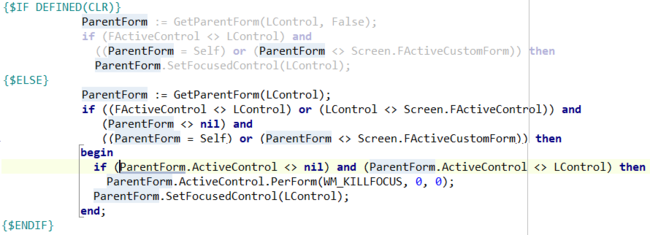
By default, matching words are highlighted when a word is selected, and the behavior can be turned off entirely if desired. Highlighting Matching Words is very responsive when changing highlights as the cursor moves, but may be distracting for some developers which is why the default value is only for selections.
Matching words are highlighted in the code editor everywhere including in comments. By default, language keywords are never highlighted. The feature is case-sensitive when using the C++ syntax highlighter.
You can enable or disable the Highlighting Matching Words in Tools > Options > User Interface > Editor and check Don't highlight keywords box. You can select how to highlight in the Highlight words drop-down box.
Smart Keys
Smart Home Key
The Smart Home Key provides a shortcut to position the cursor at the beginning of the line, and at the beginning of the text.
Pressing the HOME key when you are in the Code Editor, positions the cursor at the beginning of the line where the cursor was located; pressing the HOME key again places the cursor right before the text starts in the same line. If you keep pressing the HOME key, the cursor position toggles between the beginning of the line, and the beginning of the text.
You can enable or disable the Smart Home Key in Tools > Options > User Interface > Editor Options > Key Mappings.
Smart Surround Keys
The Smart Surround Keys provide a fast way to surround your code with "()", "[]", or "{}".
To surround your code with "()", "[]", or "{}", select the text you want to surround in the Code Editor, and click "(", "[", or "{". The Code Editor surrounds the selected text with "()", "[]", or "{}" according to the character you typed.
You can enable or disable the Smart Surround Keys in Tools > Options > User Interface > Editor Options > Key Mappings.
Selection Expansion
The Selection Expansion is a keyboard-only feature that allows you to select the word/identifier under the cursor and then expand the selection to larger syntactic groups such as statement, line, block, method, and so on.
Pressing the CTRL+W shortcut selects the identifier under the cursor. If you keep pressing the CTRL+W shortcut, the Code Editor expands the selection by logical groups, selecting the current expression, statement, block, and so on until you select the entire method, the whole implementation section, and finally the entire document.
Block Comments
You can comment-out a section of code by selecting the code in the Code Editor and pressing Ctrl+/ (slash). Each line of the selected code is prefixed with // and is ignored by the compiler. Pressing Ctrl+/ adds or removes the slashes, based on whether the first line of the code is prefixed with //. When using the Visual Studio or Visual Basic key mappings, use Ctrl+K+C to add and remove comment slashes.
Using F1 Help
What happens when you press F1 when the Code Editor is focused?
- Pressing
F1when anidentifiercorresponding to a name of a procedure, function, constant, property, variable, field, type, program, unit, library, or package described in installed CHM help files is pointed, instructs the IDE to open a help topic describing thisidentifier.- If the installed CHM help files contain exactly one help topic describing this
identifier, then this topic opens. - If more than one installed CHM help file contains topics describing this
identifier, then the IDE opens the prompt dialog box listing CHM files containing such topics. If the selected CHM file contains more than one topic describing theidentifier, the IDE opens the prompt dialog box listing all topics describing theidentifier. Select the desired one. If the selected CHM file contains exactly one topic describing theidentifier, then the IDE opens this help topic.
- If the installed CHM help files contain exactly one help topic describing this
- Note: In case of multiple topics describing an
identifier, you can additionally detail theidentifierselecting a qualified identifier. The syntax of a qualified identifier is:identifier1.identifier2. Whereidentifier1qualifiesidentifier2. For example, if you point to an identifierClear, then the IDE finds hundreds of topics describing this identifier, and it is rather complicated to select the desired topic. However, you can select the qualified identifier asTCollection.Clear. Then pressingF1directly opens the uniquely defined System.Classes.TCollection.Clear topic.
- When the
identifierrefers to more than one topic, the IDE remembers the last topic selected. PressingF1on the sameidentifieragain, the IDE does not open the prompt dialog box listing all topics describing theidentifier. Instead, the IDE opens the last topic selected. PressF1on a differentidentifierfor the IDE to forget your selection and display the dialog box listing all topics again. The IDE only remembers the selected topic of the last identifier.
- Pressing
F1, when a pointedword(ortoken) is a reserved word, directive, or C++ keyword, instructs the IDE to open a help topic describing thistoken.
- If more than one help topic is associated with this
token, then the IDE opens the prompt dialog box listing all topics describing thetoken. Select the desired topic. For example, you can see this prompt dialog box when you point to thewhilereserved word and pressF1.
- In all other cases, pressing
F1opens this Code Editor help topic.
- You can see topics associated with
identifiersin the Index tabs of the system.chm, fmx.chm, vcl.chm, libraries.chm, codeexamples.chm, data.chm help files describing supplied libraries. Index entries in these CHM files are generated automatically during the generation of CHM files from corresponding Wikis. These index entries are generated from the identifiers used in titles of Wiki topics and from global identifiers described inside topics. - You can see topics associated with
words(tokens) corresponding to reserved words, directives, or C++ keywords in the Index tab of the topics.chm help file. These index entries should be written manually in the Index topic.
Syntax Highlighter
This feature selects and displays which syntax highlighter to use for the current file. In the Code Editor status bar the options are: Delphi, C/C++, IDL, C#, SQL, HTML, Style Sheet, PHP, Java Script, INI File, or None.
Customize Editor's Font Size
You can set the editor's font size using the horizontal scroll bar from the Code Editor status bar.
The minimum value you can set for font size is 6 points, and the maximum is 30 points.
File Encoding
This feature selects and displays which file encoding to use for the current file. In the Code Editor status bar the options are: Text Form, Binary Form, Binary, Big Endian UCS-2, Little Endian UCS-2, Big Endian UCS-4, Little Endian UCS-4, UTF8, and ANSI. The default file encoding is set to ANSI.
See Also
- Video: RAD Studio 2010 Editor, by Mike Rozlog
- Video: Sync Editing in RAD Studio 2010, by Mike Rozlog
- Code Editor Context Menu
- Customizing the Code Editor
- Formatting Source Code
- Using Bookmarks
- Using Class Completion
- Using Code Folding
- Using Code Insight
- Code Insight Reference
- Using the History Manager
- Using Sync Edit
- Using the HTML Tag Editor
- Creating Live Templates
- Using Live Templates
- Creating Template Libraries
- Recording a Keystroke Macro
- Refactoring Code
- Code Completion
- XML Documentation Comments
- Using To-Do Lists
- Form Designer
- New Edit Window
- History Manager
- Key Mappings

